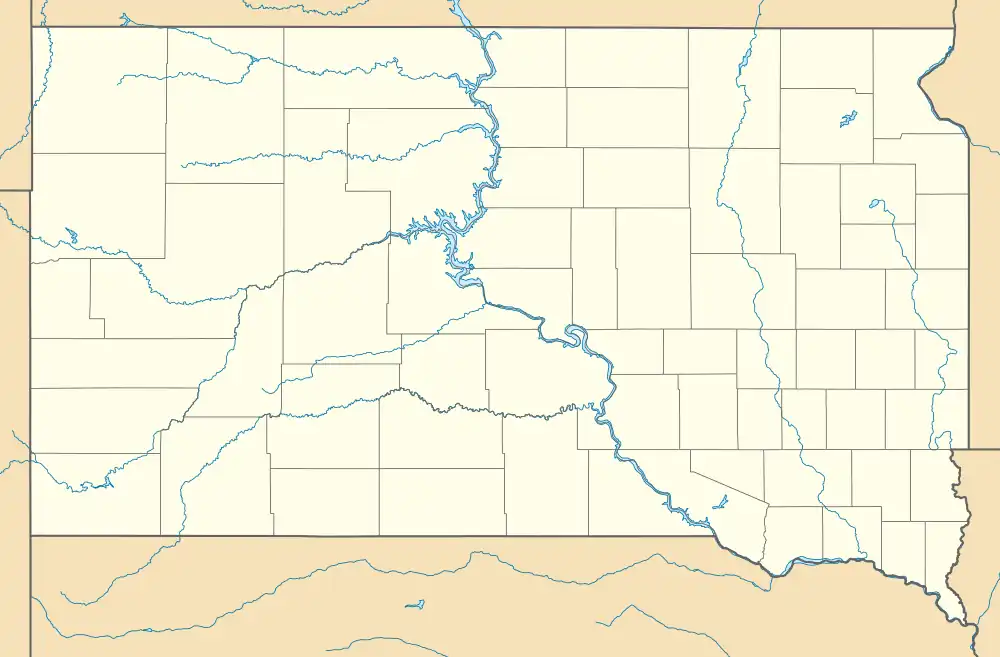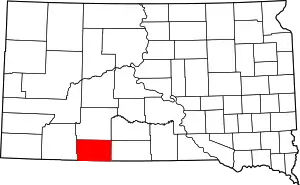Martin, South Dakota
pažóla otȟúŋwah | |
|---|---|
 Downtown Martin: Main Street, looking northeast from 4th Avenue | |
 Location in Bennett County and the state of South Dakota | |
 Martin Location within South Dakota  Martin Location within the United States | |
| Coordinates: 43°10′30″N 101°43′56″W / 43.17500°N 101.73222°W | |
| Country | United States |
| State | South Dakota |
| County | Bennett |
| Founded | 1912[1] |
| Area | |
| • Total | 0.56 sq mi (1.45 km2) |
| • Land | 0.56 sq mi (1.45 km2) |
| • Water | 0.00 sq mi (0.00 km2) |
| Elevation | 3,324 ft (1,013 m) |
| Population | |
| • Total | 938 |
| • Density | 1,672.01/sq mi (645.65/km2) |
| Time zone | UTC−7 (Mountain (MST)) |
| • Summer (DST) | UTC−6 (MDT) |
| ZIP code | 57551 |
| Area code | 605 |
| FIPS code | 46-41100[5] |
| GNIS feature ID | 1267471[3] |
| Website | http://www.martinsd.net/ |
Martin (Lakota: pažóla otȟúŋwahe;[6] "Knoll City") is a city and the county seat of Bennett County, South Dakota, United States. The population was 938 at the 2020 census.[7][8]
History
Martin was laid out in 1911.[9] The city was named for Eben Martin, a U.S. Representative from South Dakota.[10]
Geography
According to the United States Census Bureau, the city has a total area of 0.53 square miles (1.37 km2), all land.[11]
Martin has been assigned the ZIP code 57551 and the FIPS place code 41100.
Infrastructure
One of the highways that passes through Martin is U.S. Route 18, in an east–west direction. South Dakota Highway 73 runs north into the town and makes a T-intersection with U.S. 18. State Highway 73 turns into Hisle Road after the T-intersection.
Demographics
| Census | Pop. | Note | %± |
|---|---|---|---|
| 1930 | 720 | — | |
| 1940 | 1,013 | 40.7% | |
| 1950 | 989 | −2.4% | |
| 1960 | 1,184 | 19.7% | |
| 1970 | 1,248 | 5.4% | |
| 1980 | 1,018 | −18.4% | |
| 1990 | 1,151 | 13.1% | |
| 2000 | 1,106 | −3.9% | |
| 2010 | 1,071 | −3.2% | |
| 2020 | 938 | −12.4% | |
| U.S. Decennial Census[12][4] | |||
2010 census
As of the census[13] of 2010, there were 1,071 people, 401 households, and 246 families living in the city. The population density was 2,020.8 inhabitants per square mile (780.2/km2). There were 467 housing units at an average density of 881.1 per square mile (340.2/km2). The racial makeup of the city was 48.3% Native American, 41.6% White, 1.2% Asian, 0.1% African American, 0.5% from other races, and 8.3% from two or more races. Hispanic or Latino of any race were 4.1% of the population.
There were 401 households, of which 37.9% had children under the age of 18 living with them, 34.7% were married couples living together, 19.2% had a female householder with no husband present, 7.5% had a male householder with no wife present, and 38.7% were non-families. 32.7% of all households were made up of individuals, and 15.7% had someone living alone who was 65 years of age or older. The average household size was 2.58 and the average family size was 3.26.
The median age in the city was 31.7 years. 30.4% of residents were under the age of 18; 11.4% were between the ages of 18 and 24; 20.8% were from 25 to 44; 21.6% were from 45 to 64; and 15.8% were 65 years of age or older. The gender makeup of the city was 46.8% male and 53.2% female.
2000 census
As of the census[5] of 2000, there were 1,106 people, 421 households, and 253 families living in the city. The population density was 1,210.5 inhabitants per square mile (467.4/km2). There were 480 housing units at an average density of 525.3 per square mile (202.8/km2). The racial makeup of the city was 53.98% White, 0.63% African American, 37.61% Native American, 0.09% Asian, 0.36% from other races, and 7.32% from two or more races. Hispanic or Latino of any race were 3.44% of the population.
There were 421 households, out of which 33.0% had children under the age of 18 living with them, 41.8% were married couples living together, 14.5% had a female householder with no husband present, and 39.7% were non-families. 35.6% of all households were made up of individuals, and 17.6% had someone living alone who was 65 years of age or older. The average household size was 2.51 and the average family size was 3.28.
In the city, the population was spread out, with 31.6% under the age of 18, 7.6% from 18 to 24, 23.1% from 25 to 44, 19.0% from 45 to 64, and 18.7% who were 65 years of age or older. The median age was 36 years. For every 100 females, there were 90.4 males. For every 100 females age 18 and over, there were 85.1 males.
As of 2000 the median income for a household in the city was $26,779, and the median income for a family was $32,500. Males had a median income of $26,964 versus $19,632 for females. The per capita income for the city was $13,752. About 19.0% of families and 24.9% of the population were below the poverty line, including 32.5% of those under age 18 and 14.2% of those age 65 or over.
Transportation
The only transportation for Martin is by road (U.S. 18, State Highway 73), or by air (Martin Municipal Airport).
Education
The Bennett County School District serves all of Bennett County.[14]
Notable people
- Vine Deloria Jr was an author, theologian, historian, and activist for Native American rights. Born in Martin.
- Jay Novacek, an American football and College Football Hall of Fame tight end was born in Martin, South Dakota
References
- ↑ "SD Towns" (PDF). South Dakota State Historical Society. Archived from the original (PDF) on February 10, 2010. Retrieved February 14, 2010.
- ↑ "ArcGIS REST Services Directory". United States Census Bureau. Retrieved October 15, 2022.
- 1 2 U.S. Geological Survey Geographic Names Information System: Martin, South Dakota
- 1 2 "Census Population API". United States Census Bureau. Retrieved October 15, 2022.
- 1 2 "U.S. Census website". United States Census Bureau. Retrieved January 31, 2008.
- ↑ Ullrich, Jan F. (2014). New Lakota Dictionary (2nd ed.). Bloomington, IN: Lakota Language Consortium. ISBN 978-0-9761082-9-0. Archived from the original on October 18, 2016. Retrieved February 13, 2014.
- ↑ "U.S. Census Bureau: Martin, South Dakota". www.census.gov. United States Census Bureau. Retrieved December 18, 2021.
- ↑ "Find a County". National Association of Counties. Retrieved June 7, 2011.
- ↑ Federal Writers' Project (1940). South Dakota place-names, v.1-3. University of South Dakota. p. 50.
- ↑ "Profile for Martin, South Dakota". ePodunk. Archived from the original on August 4, 2016. Retrieved June 4, 2014.
- ↑ "US Gazetteer files 2010". United States Census Bureau. Archived from the original on July 2, 2012. Retrieved June 21, 2012.
- ↑ United States Census Bureau. "Census of Population and Housing". Retrieved June 7, 2016.
- ↑ "U.S. Census website". United States Census Bureau. Retrieved June 21, 2012.
- ↑ "2020 census - school district reference map: Bennett County, SD" (PDF). U.S. Census Bureau. Retrieved August 11, 2021.
